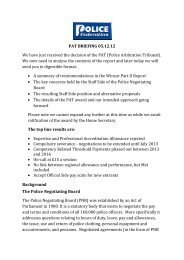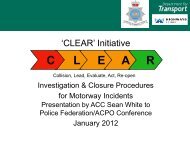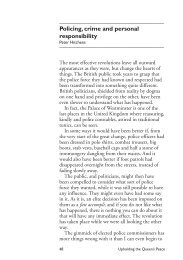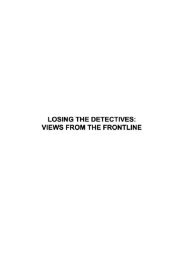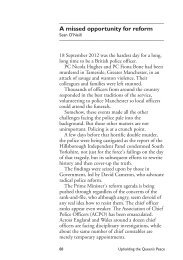Policing UK 2013 - Police Federation
Policing UK 2013 - Police Federation
Policing UK 2013 - Police Federation
You also want an ePaper? Increase the reach of your titles
YUMPU automatically turns print PDFs into web optimized ePapers that Google loves.
THE ROLE OF POLICE<br />
“It will be important for police and crime<br />
commissioners and police to continue<br />
to evolve key neighbourhood policing<br />
processes and systems.”<br />
since the mid-1990s, these were not being<br />
tracked by public perceptions.<br />
The NRPP approach was organised<br />
around three principal components:<br />
increasing local police presence by<br />
making officers visible, accessible and<br />
familiar to the public, and ensuring they<br />
act effectively to control problems;<br />
‘tuning’ the police response to focus<br />
upon the signal crimes and disorders that<br />
change how people think, feel and act in<br />
relation to their neighbourhood security<br />
by implementing a systematic community<br />
engagement methodology to diagnose<br />
what matters to people locally 4 ; and<br />
encouraging a shift towards ‘coproducing’<br />
solutions with partner agencies<br />
and local communities to try and increase<br />
traction and sustainability, and build the<br />
social capacity of communities.<br />
These parts were designed to be<br />
interacting and interlocking in terms of<br />
operational delivery. The implementation<br />
of this approach was trialled in 16 sites,<br />
in eight police forces across England and<br />
the early results from a Home Office<br />
evaluation were sufficiently positive that<br />
a decision was taken to ‘roll the approach<br />
out’ nationwide 5 . In the process it was<br />
re-branded as ‘neighbourhood policing’<br />
and some simplifications of the core<br />
components introduced.<br />
One of the key decisions attached<br />
to the national implementation was<br />
to establish neighbourhood officers<br />
as dedicated to that task. They were<br />
assigned to an area and could not be<br />
‘abstracted’ for other duties.<br />
This reflected learning from previous<br />
community policing reforms, where<br />
impact was routinely diffused by<br />
community officers being used to respond<br />
to emergencies and other non-local issues.<br />
It was also coherent with the more<br />
general tendency within British policing<br />
to understand policing as comprising<br />
a series of specialist roles, requiring<br />
particular skills and expertise.<br />
While there seems to be broad public<br />
and political support for NP, in an age<br />
of austerity some important questions<br />
are starting to be raised about whether<br />
the core processes and systems remain<br />
sustainable. There is certainly a case for<br />
thinking more innovatively about how NP<br />
assets could be used in respect of a wider<br />
range of problems. For example, in many<br />
forces, deliberate connections have been<br />
established between NP Teams (NPTs)<br />
and the ‘prevent’ strand of counterterrorism<br />
policing. There might be similar<br />
opportunities for thinking about impacting<br />
upon serious organised crime groups.<br />
There are also opportunities for<br />
development in taking community<br />
engagement more seriously. NP<br />
maintained the commitment to<br />
engagement seeded by the NRPP, but in<br />
the vast majority of forces this came to<br />
centre upon ‘PACT’ or ‘beat meetings’.<br />
While of some value in ascertaining<br />
public priorities, these are frequently not<br />
well attended – thus reducing their weight<br />
as a vehicle for public accountability. They<br />
are far less structured and systematic than<br />
the engagement pioneered under the<br />
auspices of the NRPP.<br />
Recent research on ‘community<br />
intelligence-led policing’ – which seeks to<br />
blend intelligence-led policing’s disciplined<br />
approaches to information analysis to<br />
drive focused policing interventions<br />
with an NP framework – shows how, by<br />
developing a ‘rich’ community intelligence<br />
picture through systematic community<br />
engagement, it is possible for police to<br />
intervene in a targeted fashion against<br />
public priorities 4,6 .<br />
In the context of ongoing reductions<br />
in funding this could leverage ‘smarter’<br />
policing. So, for example, rather than<br />
launching a multi-agency drug-crime<br />
initiative across a whole city, it might be<br />
possible to locate limited resources in those<br />
neighbourhoods where drugs problems<br />
are impacting upon the public’s quality of<br />
life. Similarly, rather than spreading traffic<br />
enforcement assets ‘thinly’ across all areas,<br />
they could be directed to where such issues<br />
are doing most harm.<br />
NP will undoubtedly be important<br />
for police and crime commissioners<br />
(PCCs). The officers on NPTs, of all the<br />
specialisms and units that collectively<br />
constitute modern police forces, have<br />
the most natural affinity with the core<br />
mission of the PCC role. That is, to give<br />
communities a voice and to have police<br />
be responsive to these expressed crime<br />
and security needs.<br />
This natural sympathy notwithstanding,<br />
it will be important for PCCs and police to<br />
continue to evolve key NP processes and<br />
systems. Indeed, there is a feeling that NP<br />
has been rather neglected of late, because<br />
it is viewed as a relative success. But given<br />
the remit of PCCs, it is unlikely that this<br />
policy of benign neglect will continue.<br />
1<br />
Fielding, N. (1995) Community <strong>Policing</strong>. Oxford: Clarendon<br />
Press.<br />
2<br />
Herbert, S. (2006) Citizens, Cops and Power. Chicago: University<br />
of Chicago Press.<br />
3<br />
Skogan, W. (2006) <strong>Police</strong> and Community in Chicago. New York:<br />
Oxford University Press.<br />
4<br />
Innes, M., Abbott, L., Lowe, T. and Roberts, C. (2008) ‘Seeing<br />
like a citien field experiments in community intelligence-led<br />
policing’, <strong>Police</strong> Practice and Research, 10/2: 99-114.<br />
5<br />
Tuffin, ., et al. (2006) The National eassurance <strong>Policing</strong><br />
Programme A six site evaluation. London Home Office<br />
6<br />
Lowe, T. and M. Innes (2012, in press) ‘Can we speak in<br />
confidence Community intelligence and Neighbourhood <strong>Policing</strong> v2.0’,<br />
<strong>Policing</strong> and Society.<br />
POLICING <strong>UK</strong> | 63





